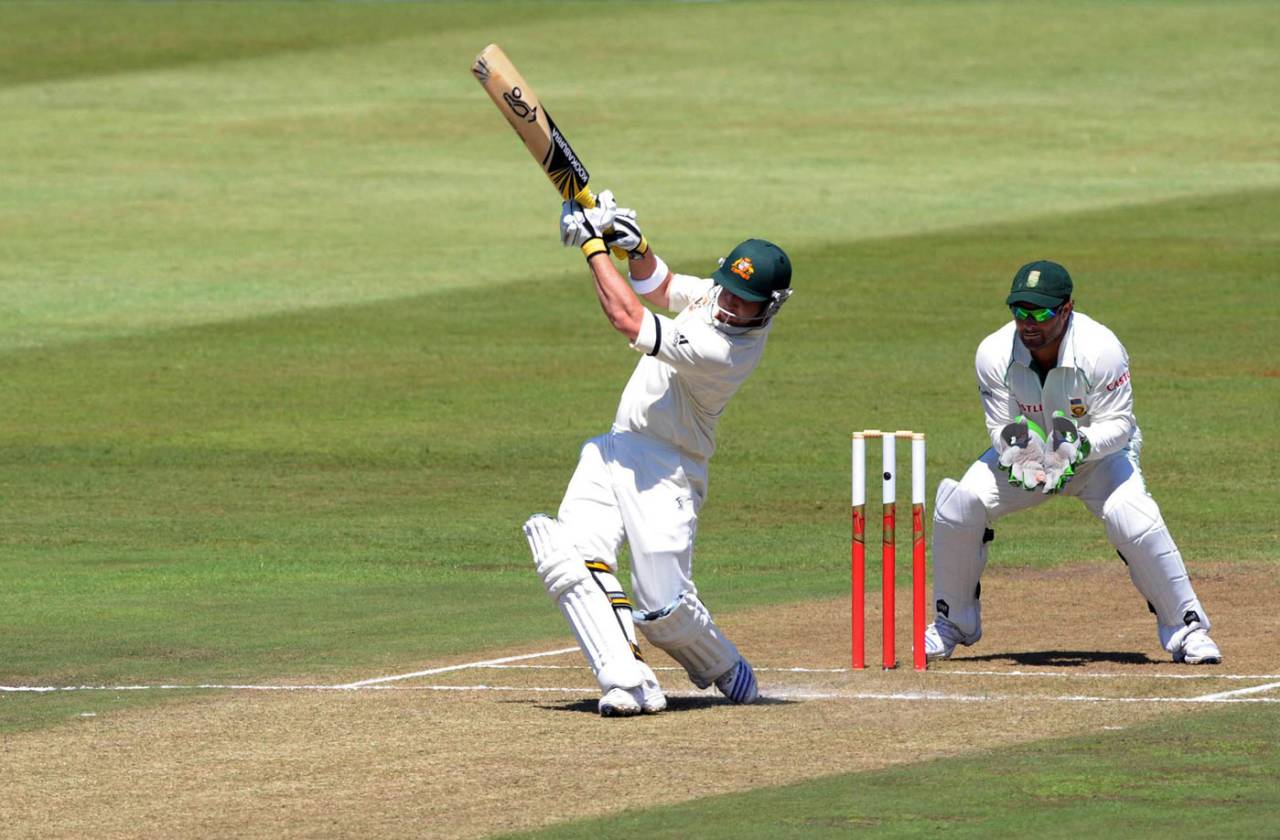The prizefighting artist
There was something quite thrilling in the expectation of watching Phillip Hughes bat. Compelling and irresistible, he left a brushstroke on the canvas of the game
Mark Nicholas
27-Nov-2014

Hughes in Durban: unusual and uncomplicated • Getty Images
Cap 408 has moved on. There was no chance to say goodbye. Phillip Hughes won his baggy green in 2009 at the age of 20. The cap is a symbol for Australia, made famous by Trumper and Bradman, but worn with equal pride by all who have followed them. Not least among those is Hughes.
These past 48 hours, the game gathered around him at St Vincent's Hospital in Sydney. They had flown from across the vast southern land, sensing danger. Their loss has no explanation. Their grief has no boundary. Their mortality is set before them.
Cricket is proven to be brutal. Men have wilted before men. The strength of one is the weakness of another. There are bullies, there are heroes. The game sorts them all out. And it takes care of its own. The cricket family was suspended in fear. The cricketers who came to Phillip's bedside wanted to take care of their own. When the dreadful news came, the opportunity had been taken from their hands.
The photographs of him tell his story. Gifted, cheeky, kind, honest and humble are words that reflect the images. Others might be "generous of spirit", "self-effacing in reflection", "unconventional in play". His batting was an adventure. From it came 26 first-class hundreds and the certainty of many more. Maybe he was to return to Australian colours next week at the Gabba, maybe not. But he would have done so soon, for he had a quite unique talent. It was a matter of time. But he ran out of time.
The blow to the head might happen to any cricketer, any day. A regulation ball - not too slow, not too fast - that he went at too early, by just a fraction. That fraction meant the end of his life. It really is that thin a line. The brutal game.
Helmets became a regular part of cricket in the late 1970s. So fast and aggressive was the bowling in World Series Cricket that Kerry Packer wanted his batsmen protected. Tony Greig, who had previously taken the brunt of Dennis Lillee and Jeff Thomson in a cloth cap, was among the first to wear the white motorbike-style crash helmet. Lillee hit him on it as if to make a point. Greig mimicked the buckling of his legs. Philip Hughes was not mimicking. The ball missed his helmet by enough to strike what we now know to be a weak area. So weak there was no way back.
The photographs of him tell his story. Gifted, cheeky, kind, honest and humble are words that reflect the images. Others might be "generous of spirit", "self-effacing in reflection", "unconventional in play"
Australia is devastated. That is not an exaggeration. It is an insular place that takes care of its own. Cricketers are an important part of the country's history and of its culture. Cricket is more than the national sport or the summer game. It is a way of life. The game is the soundtrack of summer, its players the orchestra. Around the land, as families rejoice in sunshine, warmth, light and space, cricket continues to resonate. Children play and imitate. Adults do the same or collect around barbeques, drink beer and select teams.
Many thought Hughes should be back in the team. Others disagreed. Everyone had a view. Whatever that view may have been, people liked Hughes. There was something infectious there, something quite thrilling in the expectation of him. The loss of that expectation has shaken the country to its core.
What people saw was a hunger for cricket and a respect for life. This is not a combination that every player has found, though the lesson is clear. From it has come unilateral support and national distress. He was, as Andrew Flintoff said in a tweet, "a cracking lad". Flintoff roughed him up in Test matches, and the way one man reacts to another in such a situation reveals a great deal.
Just before Flintoff got to him in the English summer of 2009, he played two innings in Durban that were extraordinary. The South African pace attack was the best going around and the splendid little fella flayed them. In the first, he made 115, hitting 19 fours and two sixes. In the second, he made 160, with a further 15 fours and three sixes.
It is difficult to paint the picture of these performances, because that is what they were. Unusual and uncomplicated, compelling and irresistible, Hughes left a brushstroke on the canvas of the game. It was a different, almost brave new world that he created in that match with his prizefighter's approach set before an artist's flourish. The sadness was that it was brief. Soon, Flintoff exposed a flaw and the selectors responded with a lack of faith. The will-he, won't-he story had begun.
Now it is over. Hughes the cricketer is a terrible loss. The death of the man, Phillip Joel Hughes, is a tragedy that will live with us forever. He was not yet 26, for goodness' sake. Not yet in his prime. We pray he had some idea of the joy he brought to so many.
Mark Nicholas, the former Hampshire captain, presents the cricket on Channel 9 in Australia and Channel 5 in the UK